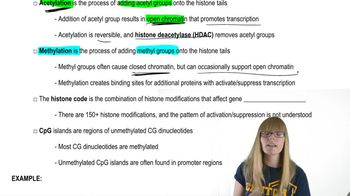The following figure contains several examples of the Shine–Dalgarno sequence. Using the seven Shine–Dalgarno sequences from E. coli, determine the consensus sequence and describe its location relative to the start codon.
Table of contents
- 1. Introduction to Genetics51m
- 2. Mendel's Laws of Inheritance3h 37m
- 3. Extensions to Mendelian Inheritance2h 41m
- 4. Genetic Mapping and Linkage2h 28m
- 5. Genetics of Bacteria and Viruses1h 21m
- 6. Chromosomal Variation1h 48m
- 7. DNA and Chromosome Structure56m
- 8. DNA Replication1h 10m
- 9. Mitosis and Meiosis1h 34m
- 10. Transcription1h 0m
- 11. Translation58m
- 12. Gene Regulation in Prokaryotes1h 19m
- 13. Gene Regulation in Eukaryotes44m
- 14. Genetic Control of Development44m
- 15. Genomes and Genomics1h 50m
- 16. Transposable Elements47m
- 17. Mutation, Repair, and Recombination1h 6m
- 18. Molecular Genetic Tools19m
- 19. Cancer Genetics29m
- 20. Quantitative Genetics1h 26m
- 21. Population Genetics50m
- 22. Evolutionary Genetics29m
11. Translation
Translation
Problem 36b
Textbook Question
The flow of genetic information from DNA to protein is mediated by messenger RNA. If you introduce short DNA strands (called antisense oligonucleotides) that are complementary to mRNAs, hydrogen bonding may occur and 'label' the DNA/RNA hybrid for ribonuclease-H degradation of the RNA. One study [Lloyd et al. (2001). Nucl. Acids Res. 29:3664–3673] compared the effect of different-length antisense oligonucleotides upon ribonuclease-H–mediated degradation of tumor necrosis factor (TNFα) mRNA. TNFα exhibits antitumor and pro-inflammatory activities. The following graph indicates the efficacy of various-sized antisense oligonucleotides in causing ribonuclease-H cleavage. What general conclusion can be drawn from the graph?
 Verified step by step guidance
Verified step by step guidance1
Examine the graph provided in the problem to identify the relationship between the length of the antisense oligonucleotides and their efficacy in causing ribonuclease-H cleavage of TNFα mRNA.
Note the trend in the graph: Does the efficacy increase, decrease, or remain constant as the length of the antisense oligonucleotides changes? Pay attention to any specific lengths that show a peak or drop in efficacy.
Consider the biological implications of the observed trend. For example, longer antisense oligonucleotides may form more stable hybrids with mRNA, but they may also be more prone to degradation or less specific in binding.
Relate the observed trend to the mechanism of ribonuclease-H activity. Ribonuclease-H cleaves RNA in DNA/RNA hybrids, so the stability and specificity of the hybrid are critical for effective cleavage.
Formulate a general conclusion based on the graph. For instance, you might conclude that there is an optimal length for antisense oligonucleotides that balances stability, specificity, and susceptibility to ribonuclease-H cleavage, leading to maximum efficacy.
 Verified video answer for a similar problem:
Verified video answer for a similar problem:This video solution was recommended by our tutors as helpful for the problem above
Video duration:
2mPlay a video:
Was this helpful?
Key Concepts
Here are the essential concepts you must grasp in order to answer the question correctly.
Gene Expression
Gene expression is the process by which information from a gene is used to synthesize a functional gene product, typically proteins. This involves two main steps: transcription, where DNA is transcribed into messenger RNA (mRNA), and translation, where mRNA is translated into a protein. Understanding this process is crucial for analyzing how antisense oligonucleotides can interfere with mRNA and affect protein synthesis.
Recommended video:
Guided course

Penetrance and Expressivity
Antisense Oligonucleotides
Antisense oligonucleotides are short, single-stranded DNA or RNA molecules designed to bind to specific mRNA sequences. By hybridizing with mRNA, they can block translation or promote degradation of the mRNA through mechanisms such as ribonuclease-H activity. This targeted approach is used in research and therapeutic applications to modulate gene expression, particularly in diseases like cancer.
Recommended video:
Guided course

X-Inactivation
Ribonuclease-H Activity
Ribonuclease-H (RNase H) is an enzyme that degrades the RNA strand of RNA-DNA hybrids. When antisense oligonucleotides bind to their complementary mRNA, RNase H can recognize and cleave the RNA, leading to reduced levels of the target mRNA. Understanding the role of RNase H is essential for interpreting the effectiveness of different-length antisense oligonucleotides in degrading specific mRNAs, such as TNFα in the context of inflammation and cancer.
Recommended video:
Guided course

Histone Protein Modifications

 7:58m
7:58mWatch next
Master Translation initiation with a bite sized video explanation from Kylia
Start learningRelated Videos
Related Practice
Textbook Question
435
views
